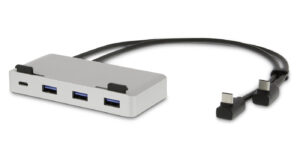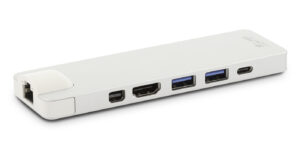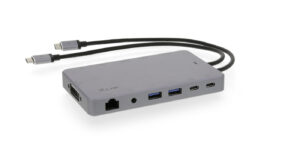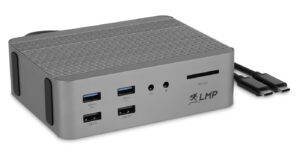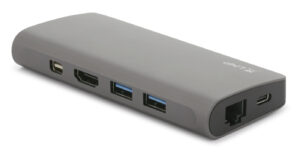LMP USB-C Basic Hub
6-port USB-C Hub with USB 3.0, SD/microSD, USB-C6
Key features
- 6-port USB-C Basic Hub
- 3x USB 3.0 port (1x with 1.5 A power output for charging smartphones and tablets)
- Plug & Play, no driver needed, bus-powered
- USB-C port supports Power Delivery (PD 3.0)
- Aluminum enclosure
Description
The compact LMP USB-C Basic Hub brings back the vital connectivity to the 12" MacBook, 13" MacBook Air or the 13" and 15" MacBook Pro: 3 USB 3.0 ports, SD and microSD card reader and a USB-C port for Power Delivery (pass-through power from USB-C power adapter to laptop).
The USB 3.0 ports transfer data from and to the laptop and are ideal for attaching multiple USB devices such as an external USB HDD/SSD enclosure, a USB mouse or a USB printer. The marked USB port (BC1.2/1.5 A) can charge a smartphone or tablet with up to 1.5 A when Power Delivery (PD) is attached. The card reader supports SD (including SDHC/XC formats) as well as microSD memory cards and transfers photos and videos quickly to the computer. The USB-C port can be used to charge the laptop (using the advanced PD 3.0 standard) and supply more power to the USB 3.0 ports (up to 3 A with PD).
Compact and versatile, the LMP USB-C Basic Hub suits the everyday needs of the digital world.
Note: Not compatible with Apple USB SuperDrive
Technical specifications
| Connection type | USB-C 3.1 |
|---|---|
| Data ports | 1x USB-A 3.0 (up to 5 Gbps, BC 1.2 up to 1.5 A)1x USB-C PD 3.0 (up to 5 Gbps)2x USB-A 3.0 (up to 5 Gbps) |
| Card reader | 1x microSD card reader1x SD card reader |
| Color | Space GraySilverGold |
| Material | Aluminum |
| Power supply | Bus-powered |
| Product dimensions (W x H x D) | 8.5 x 1 x 3 cm |
| Product weight | 35 gr |
| Package weight | 18.5 x 9 x 2 cm |
| Package dimensions (W x H x D) | 63 gr |
| Package content | LMP USB-C Basic Hub4x rubber spacer |
FAQ
FAQ Categories: Connection
The total power output to the USB 3.0 ports is limited to 2.0 A without a USB-C power adapter attached (no PD) and 3.0 A with PD. By adding another USB device, the total power consumption of all USB 3.0 ports must have gone over the 2 A (no PD) or 3.0 A (with PD), resulting in the shot-down of all USB 3.0 ports.
You must either attach the USB-C power adapter to get more power to the ports (3.0 A max.) or disconnect one of the USB devices so the total power consumption is within the limits.
Without PD (2.0 A), you can typically mount 1x external USB 2.5" HDD/SSD (bus powered), 1x USB Flash and 1x USB mouse (low-energy devices). With PD (3.0 A), you should be able to connect up to 2x external USB 2.5" HDD/SSD (bus powered) plus 1x USB Flash or 1x USB mouse (low-energy devices). Note that the power consumption of any attached device varies (e.g. depending on the type of HDD or SSD in use for 2.5" HDD/SSD and the USB-SATA PCBA in use) and therefore cannot be guaranteed.
FAQ Categories: Connection, Video
Basically, you can use only the iMac (27-inch, Late 2009) and iMac (27-inch, Mid 2010) with a Mini-DisplayPort connection with the current Mac with Thunderbolt 3 (USB-C) ports. You need a USB-C to Mini-DisplayPort adapter (e.g. 16134/16138, LMP USB-C to Mini-DisplayPort adapter) or a USB-C dock with Mini-DisplayPort port (e.g. 18641/18645/19009, LMP USB-C Travel Dock 4K 9 Port or 17113/17278/18954, LMP USB-C Compact Dock 4K 8 Port or 17116, LMP USB-C Display Dock 4K 10 Port). Then a Mini-DisplayPort to Mini-DisplayPort cable (8305, LMP Mini-DisplayPort to Mini-DisplayPort cable) must be attached to the dock and the iMac.
With iMac (Mid 2011 to Mid 2014), it is possible to use the iMac as monitor with a Thunderbolt connection only. With a newer iMac, a Target Mode with an iMac is not possible anymore.
For further details, see https://support.apple.com/hr-hr/HT204592
Affected LMP products
FAQ Categories: Hardware
It is normal that any USB-C hub or dock becomes hot when attached to the laptop. The aluminum housing is meant to dissipate the heat from the inside to the environment. There is a number of chipsets working on the inside which are producing some heat since they are constantly in a stand-by position to react quickly should any port be used. The surface temperature is well within the allowed limits and reaches about 40°C in stand-by mode, 43°C under normal use and a max. of 48°C when all ports are in full use, CPU load at 100% and PD attached. The heat does neither pose a danger to the laptop or any attached device, nor does it influence the USB-C hub's/dock's performance or even shorten the life-span.
Furthermore, the surface appears to be hotter than it actually is since it is touched with the very senstive fingertips. We suggest to remove the USB-C hub/dock when not needed in order not to emitt unnecessary heat to the environment and not to use any energy.
Affected LMP products
Compatible Mac model
MacBook (Retina, 12-inch, 2017) MacBook (Retina, 12-inch, Early 2015) MacBook (Retina, 12-inch, Early 2016) MacBook Air (15-inch, M2, 2023) MacBook Air (M1, 2020) MacBook Air (M2, 2022) MacBook Air (Retina, 13-inch, 2018) MacBook Air (Retina, 13-inch, 2019) MacBook Air (Retina, 13-inch, 2020) MacBook Pro (13-inch, 2016, Two Thunderbolt 3 ports) MacBook Pro (13-inch, 2017, Four Thunderbolt 3 Ports) MacBook Pro (13-inch, 2017, Two Thunderbolt 3 Ports) MacBook Pro (13-inch, 2018, Four Thunderbolt 3 Ports) MacBook Pro (13-inch, 2019, Four Thunderbolt 3 ports) MacBook Pro (13-inch, 2019, Two Thunderbolt 3 ports) MacBook Pro (13-inch, 2020, Four Thunderbolt 3 ports) MacBook Pro (13-inch, 2020, Two Thunderbolt 3 ports) MacBook Pro (13-inch, Late 2016, Four Thunderbolt 3 Ports) MacBook Pro (13-inch, M1, 2020) MacBook Pro (13-inch, M2, 2022) MacBook Pro (14-inch, 2021) MacBook Pro (14-inch, 2023) MacBook Pro (14-inch, M3 Pro or M3 Max, Nov 2023) MacBook Pro (14-inch, M3, Nov 2023) MacBook Pro (15-inch, 2016) MacBook Pro (15-inch, 2017) MacBook Pro (15-inch, 2018) MacBook Pro (15-inch, 2019) MacBook Pro (16-inch, 2019) MacBook Pro (16-inch, 2021) MacBook Pro (16-inch, 2023) MacBook Pro (16-inch, Nov 2023)
Mac14,2 Mac14,7 MacBook10,1 MacBook8,1 MacBook9,1 MacBookAir10,1 MacBookAir8,1 MacBookAir8,2 MacBookAir9,1 MacBookPro13,1 MacBookPro13,2 MacBookPro13,3 MacBookPro14,1 MacBookPro14,2 MacBookPro14,3 MacBookPro15,1 MacBookPro15,2 MacBookPro15,3 MacBookPro15,4 MacBookPro16,1 MacBookPro16,2 MacBookPro16,3 MacBookPro16,4 MacBookPro17,1 MacBookPro18,1 MacBookPro18,2 MacBookPro18,3 MacBookPro18,4 Mac14,10 Mac14,15 Mac14,5 Mac14,6 Mac14,9 Mac15,10 Mac15,11 Mac15,3 Mac15,6 Mac15,7 Mac15,8 Mac15,9
A1534 A1706 A1707 A1708 A1932 A1989 A1990 A2141 A2159 A2179 A2251 A2289 A2337 A2338 A2442 A2485 A2681 A2779 A2780 A2918 A2941 A2991 A2992












